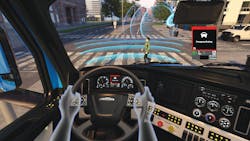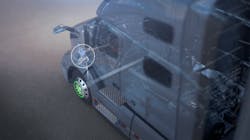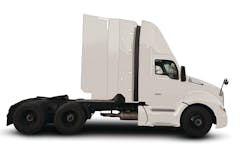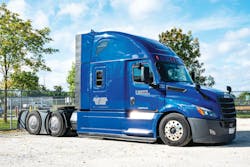Up until the end of 2019, the trucking industry was coasting and the economy soaring. Class 8 truck builds for last year were 51% higher than in 2016, according to ACT Research, a result of fleets expanding to meet demand. Experts knew it wouldn’t last forever.
Last fall, ACT Research projected the market would correct, and the build rate would drop by 31%. That was before the COVID-19 pandemic shuttered factories and closed national borders, before Zoom meetings and masks became en vogue, and handshakes were frowned upon.
“Since we put out the last fleet outlook, everything has changed,” said Steven Latin-Kasper, market data and research director for the National Truck Equipment Association (NTEA). “The pandemic moved the recession up and made it worse.”
Latin-Kasper’s most recent data had Class 8 chassis sales down by 28% and tractor sales down 40% through May. Overall, Class 8 sales dropped 35%. Due to last mile seeing a surge because of the nationwide quarantine for much of the spring and more deliveries to homes, Classes 2 through 7 were down far less at 11%. Removing Class 5, which grew over the first five months of 2020, from the equation created a 25% decrease.
Halfway through 2020, nothing is certain. The novel coronavirus crisis could slowly die out or come back with a vengeance. Regardless, the damage is done. In June, the U.S. Bureau of Labor Statistics reported roughly 18 million Americans were out of work, and escaping the economic impacts of such a high unemployment rate are highly unlikely.
Latin-Kasper, who has accrued more than 40 years of economic insights, said he is “not predicting an easy recovery.”
Fleets will still need new trucks, though. And if there’s a sliver of positivity to be had, it’s that the equipment available in 2020 is more than capable of achieving the uptime and efficiency required to outlast the onslaught of plagues besetting the industry.
Unlike the past few years, fleets aren’t as sure about their cash flow, so each expense needs to be carefully considered.
“The financial pie that we have to pay for all this stuff is only so big,” said Dave Williams, executive vice president of Knight Transportation. “You have to be very careful going out and trying to buy it all, because what you’ll find is the [maintenance] is more expensive than the problem. You’ve got to be very surgical about how you go about choosing technology and how you go about implementing technology.”
FleetOwner routinely covers how trucking equipment and technology innovations are improving fleets’ safety ratings and profitably. The two areas of notable growth that can have the most immediate impact on safety, performance and efficiency are advanced driver-assistance systems (ADAS) and aerodynamic kits.
ADAS
The jury is still out on how far autonomous technology will go in the heavy-duty sector. As defined by SAE International, Levels 1 and 2 require a human driver to be in command, while Level 3 requires some intervention, and Levels 4 (under many conditions) and 5 do not.
By processing real-time camera and sensor data, trucks can leverage these Level 2 features: adaptive cruise control to adjust speed based on proximity to other traffic, collision mitigation technology such as electronic braking systems to automatically reduce speed, and steering assist functionality.
Daimler Trucks North America (DTNA) made the 2020 Freightliner Cascadia—when spec’d with a Detroit engine and DT12 automated manual transmission—the first truck to feature the Level 2 technology. The solution can track up to 40 objects at once using bumper-mounted radar and a windshield-mounted high-definition camera. The systems work together to monitor the area surrounding the vehicle, alerting the driver. If the driver takes no action, the systems will intervene to prevent or mitigate a crash.
Standard features include the always-on Active Brake Assist 5.0 for alerts and full stopping to prevent hitting pedestrians and moving or stopped vehicles or objects, as well as the adaptive cruise control to ensure a continuous following distance of 2.3 to 3.5 seconds. The camera also identifies lane markers to alert the driver when the truck veers out of its lane, unless the turn signal is active. Optional features include Active Lane Assist to keep the truck in its lane through the use of “micro-steering.”
Even with a down economy and the COVID-19 effect, the new offering has proved too enticing for fleets to pass up.
“We waited until May, so we were able to get the Detroit Assurance 5.0 in those trucks,” said Dennis Dellinger, president & CEO of Cargo Transporters Inc., a fleet of more than 525 trucks. “We had a little bit of delay because of the factory closing, but we did tag 10 trucks [in mid-June] and are planning to tag 10 more.”
DTNA reported that 90% of Cascadias equipped with the Detroit powertrain complement have added Detroit Assurance 5.0.
The latest generation of Bendix Wingman Fusion, released last fall, also provides Level 2 automation through the addition of upgrades, which will include Traffic Jam Assist, Highway Assist, and Pedestrian/Cyclist Alerts, along with steering capabilities such as Lane Keeping Assist and Lane Centering. Updates will allow for electronic braking systems in the next two years.
“With significantly increased radar and camera performance—which also enables greatly enhanced object detection, including road signs—we improve all of Fusion’s existing features and unlock many more advanced functions, up to SAE Level 2,” explained T.J. Thomas, director of marketing and customer solutions for Bendix.
When released in 2015, Wingman Fusion was able to slow down by 30 mph to mitigate a crash. Now that speed is 50 mph. “There’s no such thing as a minor crash, but reducing the severity of the crashes and taking up to an extra 20 miles per hour out of it is a big deal,” Thomas said.
Along with safety, ease of driving is also at the forefront. The Volvo Group, through both Volvo Trucks North America and Mack Trucks, has introduced a driver-assist technology, an electric motor connected to the hydraulic steering column, that makes turning the wheel far easier when backing into a spot or just fighting crosswind on the highway. Volvo calls it Dynamic Steering; Mack calls it Command Steer.
He explained that overall, Fusion eliminates about 70% of rear-end crashes and reduces the severity of other crashes by 70%. Thomas said the solution has demonstrated return on investment on the fleet side and preventing even one accident provides incredible value. A fatality can cost $10 million and several hundred thousand dollars for injuries, he said.
“The nuclear verdicts are so big that doing better on one of them makes a difference,” Thomas said, referring to jury-awarded legal penalties in excess of $10 million. He argued that avoiding a fatal crash offsets the cost of spec’ing an entire fleet’s safety systems.
Having the safety system cameras benefit in the future as well as the present. Safety directors can take near-miss events and train individuals or groups of drivers on good and bad behavior that may have caused the near miss or prevented a catastrophic accident. Bendix’s safety training aid is called SafetyDirect.
“We’ve seen that Bendix Wingman Fusion has given our drivers more time to react in crucial situations—because even the best driver can’t control things that happen on the road around them,” said Jeff Mercadante, vice president of safety at Pitt Ohio. “By pairing it with SafetyDirect, we can sharpen our training programs to assist drivers in specific and targeted ways, which benefits both safety and efficiency.”
None of this happened overnight, as Bendix has been steadily tweaking the effectiveness since 2009 with Wingman Advanced. Fusion comes standard on Navistar International’s LT, RH and LoneStar; Kenworth’s T680, Peterbilt 5; and Mack’s Anthem, Granite and Pinnacle models.
“For 2020, of the most significant trends we’re seeing is the inclusion of collision mitigation in our vehicles,” said Jim Nachtman, marketing director of Navistar’s Heavy Duty Product Segment. He said on the LT Series, adding collision mitigation, which may also include Wabco’s OnGuard Active, has increased by 10% this year. The Bendix BlindSpotter side object detection system has doubled on the LT and RH Series. This system guard detects vehicles sneaking up on the sides of the trailer.
“This is another technology that we would anticipate will continue to really explode in popularity moving forward,” Nachtman said.
Along with safety, ease of driving is also at the forefront. The Volvo Group, through both Volvo Trucks North America and Mack Trucks, has introduced an assistive technology, an electric motor to the hydraulic steering column ,that makes turning the wheel far easier when backing into a spot or just fighting crosswind on the highway. Volvo calls it Dynamic Steering; Mack calls it Command Steer.
Those who haven’t driven a big rig for many hours at a time may not appreciate what a repetitive and exhausting exercise for muscles and joints it can be over the course of a shift. Extrapolate that over a few years and a driver will truly feel the road aching in their bones.
Mack said the solution reduces driver effort of turning the wheel by up to 85%.
“With Mack Command Steer, we’re helping reduce driver fatigue and muscle strain by up to 30%, improving safety and productivity, as well as helping to protect the truck’s most valuable asset: the driver,” said Stu Russoli, highway product manager at Mack.
Aerodynamic kits
The smoother profiles of newer trucks and spaceship-like contours on next-gen trucks such as the Tesla Semi or concepts such as the Shell Starship and Hyundai HDC-6 Neptune already indicate how original equipment manufacturer (OEM) engineers are trying to overcome air resistance and improve efficiency.
The U.S. Department of Energy said that at highway speeds, an estimated 53% of a Class 8 truck’s engine power goes to overcoming aerodynamic drag. An oft-overlooked area is the gap between the tractor and trailer.
XStream Trucking, founded in 2016, created a dynamic solution to close this gap with TruckWings. These glass-reinforced panels expand on the highway above 50 mph and fold in when under that threshold to allow the truck to turn. Deployed on several hundred UPS compressed natural gas trucks, the solution provides an average fuel savings of 4 to 6%. At a cost of $4,000, the return on investment can come in 12 to 15 months.
TruckWings look to be a more familiar sight on trucks across the country.
“We already sold twice as many in 2020 as we did all in 2019—and that’s with COVID,” said XStream Trucking CEO Daniel Burrows, who added the aerodynamic equipment is used on 2 million miles a week and by several of top 10 fleets.
“In our 2019 fleet survey, 8.2% of the responding fleets were adopting tractor gap reducers versus 0.6% last year, making this the fastest growing area for fuel economy in our report,” said Mike Roeth, executive director of the North American Council on Freight Efficiency (NACFE).
FlowBelow Aero Inc. offers a complementary option called the Tractor AeroKit, comprised of wheel covers and drive axle wheel fairings for Class 8 trucks. They provide up to 2.23% fuel savings, and as of 2020 are available at the factory level from all major truck OEMs. These include as individual options or as part of truck makers’ fuel-efficiency packages.
As of last year, trailer manufacturers, including Utility, Great Dane, Wabash National, and Hyundai, have received FlowBelow’s Trailer AeroSlider kits directly.
According to NACFE, wheel cover adoption for tractors increased 66% year over year from 2018 to 2019, while trailer covers grew 24%.
FlowBelow also noted that “every fleet that ran in the NACFE Run on Less challenge and seven of 10 fleets that ran the NACFE Regional Run on Less had outfitted their trucks and/or trailers with FlowBelow Products.”
“We confirmed the savings and durability of the FlowBelow AeroKit through a 50-50 test of 200 trucks. We now include the AeroKit with all of our new truck orders and have the product installed through our dealer, thereby saving time and money,” said Paul Pettit, vice president of maintenance for P.A.M. Transport.
Another approach for trailers is to add fairing kits such as the Michelin Energy Guard, which consists of a trailer skirt, sliding brackets, trailer end fairings, a wake reducer, and aerodynamic mud flaps. Mesilla Valley Transportation (MVT) reported 8.7% fuel savings at 65 mph. Third-party testing showed an average 10 gallons of fuel saved per 1,000 miles.
“The Michelin Energy Guard aerodynamic kit has the potential to be a game-changing solution for fleets,” said Daryl Bear, lead engineer and chief operating officer of MVT Solutions.
For those grabbing a calculator and adding each of these solutions together, a word of caution. “It’s not a ‘one plus one equals two’ equation,” Burrows said. “Bringing things into effect in one area can increase the effectiveness of things or decrease the effects.”
He recommends running tests to see how the equipment works together.
“If you have a lot of turbulence in that gap, then you get turbulence running all the way down your trailer, and therefore the boat tail and other things have less effect,” Burrows explained. “But if you’re streamlined up front, and you have the laminar flow going down the trailer, then actually it can be more effective, so it’s actually a ‘one plus two equals 2.2’ result.’”
One other thing Burrows noticed is that fleet customers are savvier in their understanding of aerodynamics. Instead of explaining how the physics behind drag and resistance on the road work, salespeople are fielding questions on specific total cost of ownership and if they can get a payback in a year.
That’s also seen at the OEM level.
“I think small fleets all the way up to the biggest mega fleets are definitely getting more sophisticated in terms of their questions,” said Nachtman, who revealed that newer technologies on International 2020 models overall delivered 8% better fuel efficiency than in 2019. “For example, they may have asked what the price was years ago and now the conversation is, ‘What is the return on investment for that technology?’”
In a time when the biggest trend is not knowing what horrible crisis comes next, finding equipment that can help predict and lower costs will at least mitigate the damage 2020 inflicts. And that’s the best the industry can hope for right now.








